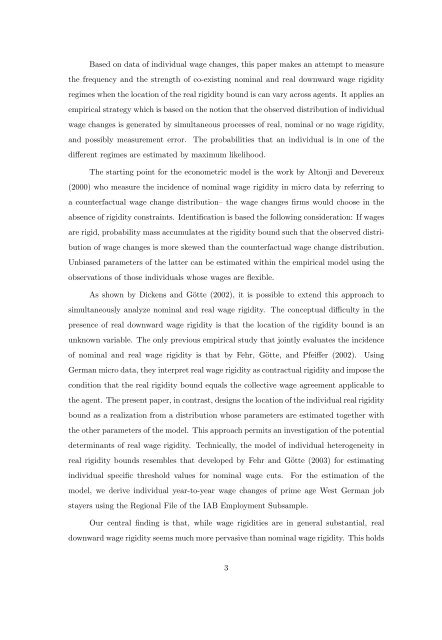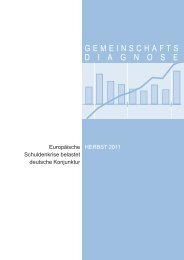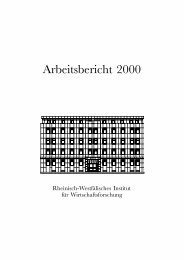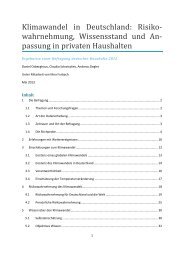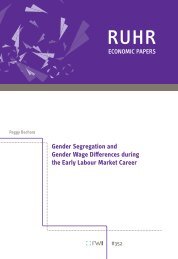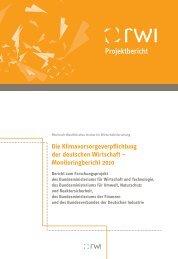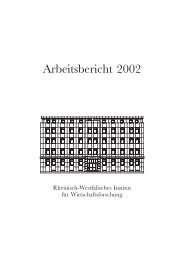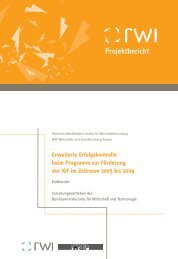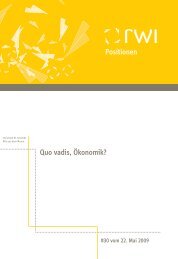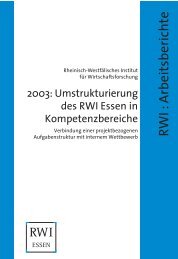RW I:Discussion Papers - Rheinisch-Westfälisches Institut für ...
RW I:Discussion Papers - Rheinisch-Westfälisches Institut für ...
RW I:Discussion Papers - Rheinisch-Westfälisches Institut für ...
Create successful ePaper yourself
Turn your PDF publications into a flip-book with our unique Google optimized e-Paper software.
Based on data of individual wage changes, this paper makes an attempt to measure<br />
the frequency and the strength of co-existing nominal and real downward wage rigidity<br />
regimes when the location of the real rigidity bound is can vary across agents. It applies an<br />
empirical strategy which is based on the notion that the observed distribution of individual<br />
wage changes is generated by simultaneous processes of real, nominal or no wage rigidity,<br />
and possibly measurement error. The probabilities that an individual is in one of the<br />
different regimes are estimated by maximum likelihood.<br />
The starting point for the econometric model is the work by Altonji and Devereux<br />
(2000) who measure the incidence of nominal wage rigidity in micro data by referring to<br />
a counterfactual wage change distribution– the wage changes firms would choose in the<br />
absence of rigidity constraints. Identification is based the following consideration: If wages<br />
are rigid, probability mass accumulates at the rigidity bound such that the observed distribution<br />
of wage changes is more skewed than the counterfactual wage change distribution.<br />
Unbiased parameters of the latter can be estimated within the empirical model using the<br />
observations of those individuals whose wages are flexible.<br />
As shown by Dickens and Götte (2002), it is possible to extend this approach to<br />
simultaneously analyze nominal and real wage rigidity. The conceptual difficulty in the<br />
presence of real downward wage rigidity is that the location of the rigidity bound is an<br />
unknown variable. The only previous empirical study that jointly evaluates the incidence<br />
of nominal and real wage rigidity is that by Fehr, Götte, and Pfeiffer (2002). Using<br />
German micro data, they interpret real wage rigidity as contractual rigidity and impose the<br />
condition that the real rigidity bound equals the collective wage agreement applicable to<br />
the agent. The present paper, in contrast, designs the location of the individual real rigidity<br />
bound as a realization from a distribution whose parameters are estimated together with<br />
the other parameters of the model. This approach permits an investigation of the potential<br />
determinants of real wage rigidity. Technically, the model of individual heterogeneity in<br />
real rigidity bounds resembles that developed by Fehr and Götte (2003) for estimating<br />
individual specific threshold values for nominal wage cuts. For the estimation of the<br />
model, we derive individual year-to-year wage changes of prime age West German job<br />
stayers using the Regional File of the IAB Employment Subsample.<br />
Our central finding is that, while wage rigidities are in general substantial, real<br />
downward wage rigidity seems much more pervasive than nominal wage rigidity. This holds<br />
3


